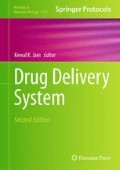Abstract
Drug and cell delivery systems could be modulated to serve as instructive microenvironments in regenerative medicine. Towards this end, several synthetic biomaterials have been developed to mimic the natural extracellular matrix (ECM) for therapeutic use. These include synthetic polymers, decellularized ECM, self-assembling polymers, and cell-responsive hydrogels with varied applications. Here, we describe the development of a self-assembling peptide hydrogel and its potential use as a cell and growth factor delivery vehicle to the infarcted heart in a rodent model of myocardial infarction.
Access this chapter
Tax calculation will be finalised at checkout
Purchases are for personal use only
References
Hammond NA, Kamm RD (2013) Mechanical characterization of self-assembling peptide hydrogels by microindentation. J Biomed Mater Res B Appl Biomater 101:981–990
Segers VF, Lee RT (2007) Local delivery of proteins and the use of self-assembling peptides. Drug Discov Today 12:561–568
Semino CE, Kasahara J, Hayashi Y, Zhang S (2004) Entrapment of migrating hippocampal neural cells in three-dimensional peptide nanofiber scaffold. Tissue Eng 10:643–655
Genove E, Shen C, Zhang S, Semino CE (2005) The effect of functionalized self-assembling peptide scaffolds on human aortic endothelial cell function. Biomaterials 26:3341–3351
Genove E, Schmitmeier S, Sala A, Borros S, Bader A, Griffith LG, Semino CE (2009) Functionalized self-assembling peptide hydrogel enhance maintenance of hepatocyte activity in vitro. J Cell Mol Med 13:3387–3397
Kisiday J, Jin M, Kurz B, Hung H, Semino C, Zhang S, Grodzinsky AJ (2002) Self-assembling peptide hydrogel fosters chondrocyte extracellular matrix production and cell division: implications for cartilage tissue repair. Proc Natl Acad Sci U S A 99:9996–10001
Bokhari MA, Akay G, Zhang S, Birch MA (2005) The enhancement of osteoblast growth and differentiation in vitro on a peptide hydrogel-polyHIPE polymer hybrid material. Biomaterials 26:5198–5208
Padin-Iruegas ME, Misao Y, Davis ME, Segers VF, Esposito G, Tokunou T, Urbanek K, Hosoda T, Rota M, Anversa P, Leri A, Lee RT, Kajstura J (2009) Cardiac progenitor cells and biotinylated insulin-like growth factor-1 nanofibers improve endogenous and exogenous myocardial regeneration after infarction. Circulation 120:876–887
Pendergrass KD, Boopathy AV, Seshadri G, Maiellaro-Rafferty K, Che PL, Brown ME, Davis ME (2013) Acute preconditioning of cardiac progenitor cells with hydrogen peroxide enhances angiogenic pathways following ischemia-reperfusion injury. Stem Cells Dev 22(17):2414–2424
Davis ME, Hsieh PC, Takahashi T, Song Q, Zhang S, Kamm RD, Grodzinsky AJ, Anversa P, Lee RT (2006) Local myocardial insulin-like growth factor 1 (IGF-1) delivery with biotinylated peptide nanofibers improves cell therapy for myocardial infarction. Proc Natl Acad Sci U S A 103:8155–8160
Liu X, Wang X, Wang X, Ren H, He J, Qiao L, Cui FZ (2013) Functionalized self-assembling peptide nanofiber hydrogels mimic stem cell niche to control human adipose stem cell behavior in vitro. Acta Biomater 9:6798–6805
Lin YD, Luo CY, Hu YN, Yeh ML, Hsueh YC, Chang MY, Tsai DC, Wang JN, Tang MJ, Wei EI, Springer ML, Hsieh PC (2012) Instructive nanofiber scaffolds with VEGF create a microenvironment for arteriogenesis and cardiac repair. Sci Transl Med 4(146):146ra109
Kyle S, Aggeli A, Ingham E, McPherson MJ (2009) Production of self-assembling biomaterials for tissue engineering. Trends Biotechnol 27:423–433
Acknowledgements
This work was supported by grant HL094527 to M.E.D. from the National Heart, Lung, and Blood Institute, an American Heart Association predoctoral fellowship 11PRE7840078 to A.V.B.
Author information
Authors and Affiliations
Editor information
Editors and Affiliations
Rights and permissions
Copyright information
© 2014 Springer Science+Business Media, New York
About this protocol
Cite this protocol
Boopathy, A.V., Davis, M.E. (2014). Self-Assembling Peptide-Based Delivery of Therapeutics for Myocardial Infarction. In: Jain, K. (eds) Drug Delivery System. Methods in Molecular Biology, vol 1141. Humana Press, New York, NY. https://doi.org/10.1007/978-1-4939-0363-4_10
Download citation
DOI: https://doi.org/10.1007/978-1-4939-0363-4_10
Published:
Publisher Name: Humana Press, New York, NY
Print ISBN: 978-1-4939-0362-7
Online ISBN: 978-1-4939-0363-4
eBook Packages: Springer Protocols

